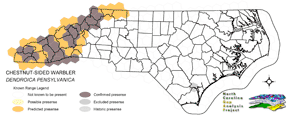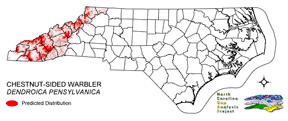
| Taxa: |
| Order: |
| Family: |
| Aves |
| Passeriformes |
| Parulidae |
| NatureServe Global Rank: |
| NatureServe State (NC) Rank: |
| G5 |
| S5B,SZN |
| Federal Status: |
| NC State Status: |
| --- |
| --- |


| Land Unit |
| US Fish & Wildlife Service |
| US Forest Service |
| US National Park Service |
| US Department of Defense |
| NC State Parks |
| NC University System |
| NC Wildlife Res. Com. |
| NC Forest Service |
| NC Div. of Coastal Mgmt. |
| Local Governments |
| Non-Governmental Org. |
| Other Public Lands |
| Private Lands |
| GAP Status 1-2 |
| All Protected Lands |
| Statewide |
| Hectares |
| 0.00 |
| 188,634.78 |
| 0.00 |
| 82,740.78 |
| 1,758.60 |
| 67.23 |
| 2,685.51 |
| 547.17 |
| 0.00 |
| 5,218.11 |
| 5,834.16 |
| 7.83 |
| 341,289.99 |
| 113,689.50 |
| 287,347.38 |
| 628,784.16 |
| Acres |
| 0.00 |
| 466,126.60 |
| 0.00 |
| 204,456.88 |
| 4,345.59 |
| 166.13 |
| 6,636.04 |
| 2,061.82 |
| 0.00 |
| 12,894.23 |
| 14,416.52 |
| 19.35 |
| 843,345.77 |
| 281,642.55 |
| 710,760.44 |
| 1,554,468.93 |
| % of Dist. on |
| Prot. Lands |
| 0.0 % |
| 65.6 % |
| 0.0 % |
| 28.8 % |
| 0.6 % |
| < 0.1 % |
| 0.9 % |
| 0.2 % |
| 0.0 % |
| 2.0 % |
| 2.0 % |
| < 0.1 % |
| 0.0 % |
| 39.6 % |
| ----- |
| ----- |
| % of Dist. on |
| All Lands |
| 0.0 % |
| 30.0 % |
| 0.0 % |
| 13.2 % |
| 0.3 % |
| < 0.1 % |
| 0.4 % |
| < 0.1 % |
| 0.0 % |
| 0.8 % |
| 0.9 % |
| < 0.1 % |
| 54.3 % |
| 18.1 % |
| ----- |
| ----- |
|
In North Carolina, breeds only in the mountain region (Pearson 1959). Inhabits brushy areas in over-grown fields (Pearson 1959), heath balds (Kendeigh and Fawver 1981), mountain laurel thickets, thickets of young chestnuts (Dunn and Garrett 1997), and sapling-sized clear-cut areas (Mitchell and Stedman 1993); can also be found within mature deciduous or coniferous forests wherever there exists a brushy place with a gap in the canopy due to fire, windfallen trees, blight, logging, etc. (Stupka 1963, Alsop 1991). In the spruce-fir zone, birds breed in mountain ash saplings, which often sprout in these gaps, and also where the spruce and fir are in early successional stages (Kendeigh and Fawver 1981). Nests are well-concealed, placed low (1-3 feet above ground) in a shrub, tangled vine (Griscom and Sprunt 1957), or sapling (Dunn and Garrett 1997). The warblers forage in the bottom half of shrubs and in the lower branches of tall trees, where they glean insects and spiders, and occasionally seeds and berries (Curson et al. 1994). NATURE SERVE GLOBAL HABITAT COMMENTS: Open deciduous woodland, forest edge, second growth, and brushy areas; in migration and winter also in various forest, woodland, scrub, and thicket habitats (AOU 1983). Common breeder in mountains over 1050 m; occurs down to 600 m elevation (Hamel 1992). Winters on the edges of and in disturbed parts of lowland forest (Pashley 1989). Nests in fork in sapling, shrub, thicket, or vine tangle, within about 1 m of ground (Harrison 1978). |
| Code | Name | Description | NC Natural Heritage Program Equivalent |
| 220 | Piedmont Xeric Pine Forests | Dry to xeric pine forests dominated by Virginia pine, shortleaf pine or Eastern Red Cedar. | Pine Oak Heath |
| 202 | Residential Urban | Includes vegetation interspersed in residential areas. Includes lawns, mixed species woodlots, and horticultural shrubs. Vegetation accounts for between 20 - 70% of the cover. | No equivalent |
| 521 | Spruce/Fir Forest | High Elevation Frazer-Fir - Red Spruce, Red Spruce and Red-Spruce-Yellow Birch Forests. Tree densities included here include both woodland to forest density. Highly intermixed with Northern Hardwoods, Grassy Balds, and Shrub Balds. | Red Spruce--Fraser Fir Forest, Fraser Fir Forest |
| 522 | Northern Hardwoods | High Elevation forests including yellow birch, American beech, and yellow buckeye. Includes forests with Hemlock and Yellow Birch. | Northern Hardwoods Forest, Boulderfield Forest |
| 524 | Shrub Bald | Variable phenologies, predominantly evergreen balds with rhododendon and Mountain laurels. Deciduous shrubs including green alder and Alleghany and smooth blackberry are included as well. Red Oak - Chestnut Oak Woodlands may be included in cases where the density of the woodland species is low and the shrub component is dense. | Heath Bald |
| 525 | Appalachian Oak Forest | A variety of oak forest types including Black, White, Scarlet Oaks in dry to mesic situations. Includes forests historically co-dominated by American Chestnut. | High Elevation Red Oak Forest, Montane White Oak Forest |
| 526 | Appalachian Cove Forest | Mixed Mesophytic forests of the mountains. Includes tuliptree, basswood, yellow buckeye and surgar maple. This class is mapped to include cove forests dominated or co-dominated by hemlock. | Rich Cove Forest, Acidic Cove Forest |
| 527 | Appalachian Hemlock | Upland hemlock forests of the moutains region. Vary from side slopes to steep slope positions. | Canada Hemlock Forest |
| 528 | Appalachian Xeric Pine Forest | Pine forests and woodlands on xeric sites. A variety of pines, including Virginia, Shortleaf, Eastern White Pine, Table Mountain and Pitch pine. Often small areas of dense pine within a matrix of Xeric Oak-Pine Forests. | Pine Oak Heath |
| 529 | Appalachian Xeric Mixed Forest | Mixed forests with Virginia, Shortleaf, Eastern White Pine, Table Mountain and Pitch pines in combination with xeric oak species. Oaks include, white, Southern Red, black, and rock chestnut. | Pine Oak Heath |
| 530 | Appalachian Xeric Deciduous Forest | Deciduous forests in the mountains dominated by Xeric Oak species. Species include, white, Southern red, black, and rock chestnut. | High Elevation Red Oak Forest, Montane White Oak Forest |
|
Greenberg, R. 1981. Frugivory in some migrant tropical forest wood warblers. Biotropica 13:215-223.
Kendreigh, S.C. and B. Fawver. 1981. Breeding bird populations in the Great Smoky Mountains, Tennessee ad North Carolina. Wilson Bulletin: 93:218-42. Mitchell, L.J. and B.H. Stedman. 1993. BBC 39—Mature maple-beech-birch forest. Journal of Field Ornithology (supplement) 64:57-8. Bent, A.C. 1953. Life histories of North American wood warblers. U.S. Natl. Mus. Bull. 203. Washington, D.C. Hagan, J.M., III, and D.W. Johnston, editors. 1992. Ecology and conservation of neotropical migrant landbirds. Smithsonian Institution Press, Washington, D.C. xiii + 609 pp. Hamel, P. B. 1992. The land manager's guide to the birds of the south. The Nature Conservancy, Chapel Hill, North Carolina. 367 pp + several appendices. Sauer, J.R., and S. Droege. 1992. Geographical patterns in population trends of neotropical migrants in North America. Pages 26-42 in J.M. Hagan III and D.W. Johnston, editors. Ecology and conservation of neotropical migrant landbirds. Smithsonian Institu Dunn, J.L., and K.L. Garrett. 1997. A field guide to warblers of North America. Houghton Mifflin Company, Boston. Stupka A 1963. Notes on the birds of the Great Smoky Mountains National Park. Knoxville: The University of Tennessee Press. Harrison, C. 1978. A field guide to the nests, eggs and nestlings of North American birds. Collins, Cleveland, Ohio. Griscom, L., and A. Sprunt, Jr. 1979. The warblers of America. Doubleday and Co., Garden City, New York. 302 pp. Terres, J.K. 1980. The Audubon Society encyclopedia of North American birds. Alfred A. Knopf, New York. American Ornithologists' Union (AOU), Committee on Classification and Nomenclature. 1983. Check-list of North American Birds. Sixth Edition. American Ornithologists' Union, Allen Press, Inc., Lawrence, Kansas. National Geographic Society (NGS). 1983. Field guide to the birds of North America. National Geographic Society, Washington, D.C. Raffaele, H.A. 1983. A guide to the birds of Puerto Rico and the Virgin Islands. Fondo Educativo Interamericano, San Juan, Puerto Rico. 255 pp. Greenberg, R. 1984. The winter exploitation systems of bay-breasted and chestnut-sided warblers in Panama. Univ. California Pub. Zool. 116:x + 107 pp. Harrison, H.H. 1984. Wood warblers' world. Simon and Schuster, New York. 335 pp. Ridgely, R.S., and G. Tudor. 1989. The birds of South America. Vol. 1. The Oscine passerines. Univ. Texas Press, Austin. 516 pp. Stiles, F.G., and A.F. Skutch. 1989. A guide to the birds of Costa Rica. Comstock Publ. Associates, Cornell University Press, Ithaca, New York. 511 pp. Alsop FJ III. 1991. Birds of the Smokies. Gatlinburg: Great Smoky Mountains Natural History Association. Pashley, D. N. 1989. Pashley contracted with the Latin America Program to update and expand the distribution information of neotropical migrant birds. This SA code indicates information based on his personal observations. |
For more information please contact them at:
NC-GAP Analysis Project
Dept. of Zoology, NCSU
Campus Box 7617
Raleigh, NC 27695-7617
(919) 513-2853
www.basic.ncsu.edu/ncgap